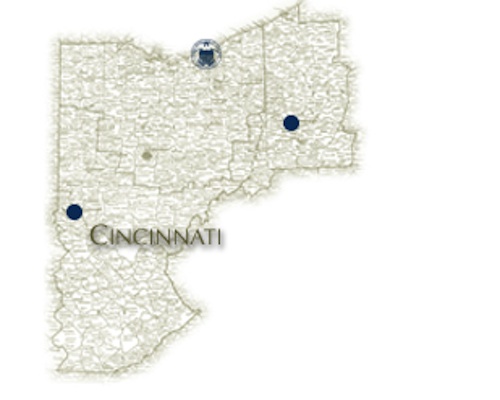Above, that is Denise Link; she’s the Board Chair of the Cleveland Metropolitan School District, and at the end of last month, she won the Urban Educator of the Year award from the Council of Great City Schools. When this was announced on Cleveland.com, the first comment was simple: “Great! Awards for failure!” Cleveland just got into bed with Teach for America (full disclosure: I am an alum of that program) and has a new partnership with MetroHealth to help curb absenteeism, but is also currently hoping someone else will pay for their idea to shift from textbooks to tablets. Here’s their 2011-12 report card. Admittedly, this was two schools years ago, but … Cleveland met zero of 26 state indicators, was below on value-added measures, didn’t make adequate yearly progress, etc. In back-to-back years, it scored an ‘F’ then a ‘D’ in terms of evaluating Ohio public school districts.
Meanwhile, 249 miles to the southwest is Cincinnati, which is becoming something of a benchmark for turning around urban school districts. Their boss, Mary Ronan, has been associated with the district since 1976 (she was teaching middle school then); her focus is on community engagement as a way to fix schools.
They launched a program called Strive, profiled in detail here, which is essentially a core group of 300 local leaders who agreed to put aside individual/organizational objectives and work on some of the big problems in Cincinnati-area schools. This has led to several key performance metrics trending in the right direction. They are now awarding a “Pinnacle Award” for community involvement in the schools; James Berry won the first such award. They also seem to be paying some of their support staff, or, at the very least, be amenable to giving them periodic raises.
I taught in the inner city (in Houston) for two years; I’ve danced around the idea of getting back into it at several other times, but so far, it hasn’t worked out, be it timing, me being a crappy candidate, etc. It was, and probably will remain, the most significant thing I’ve ever done. If you read that Stanford link profiling the Strive program, it begins with the concession that the grand scope and scale of American public education has confounded reform efforts for decades. That’s mostly true. There a million different opinions on No Child Left Behind (although most end in the same place: it wasn’t a good idea), and here’s mine: it was essentially a way to take an MBA-type model and apply it to public education. Numbers, big data, accountability. Schools do need that, and Cincinnati’s model is very data-driven, but … the core really needs to be a connection to the community the school is serving. What challenges are these students facing that might be different than challenges faced in Dallas? One size most assuredly does not fit all. How do you make a community care about education when there are other, more pressing, economic day-to-day concerns? Community involvement, right down to parent involvement, is crucial.
None of this is meant to say that Denise Link didn’t deserve that award; she probably did, and the situation in Cleveland is a very tough, very uphill turnaround. She should be commended. We spend a lot of time discussing, flying people to conferences on, debating online, and screaming about urban education reform — NPR is doing a series on Philadelphia right now — but it’s kind of a deceptively simple model: establish good relationships, work with the community, bring in community leaders, think in terms of data, and hire the best teachers you can.
Now, it also helps that Cincinnati is doing solid things in terms of food students are eating, bullying, and going green. They also have some strong ties to General Electric in the area, which seems to be mostly a success story:
I know it sounds incredibly trite, but education really is the cornerstone of everything — both in terms of the knowledge we gain, but also the socialization abilities we develop and inhabit. It’s ignored like a mofo in this country; in 2008’s Presidential debates, it was barely mentioned. In 2012, it was mentioned more, although some of the more controversial aspects stayed out. We need to see these education success stories and figure out if the model — or, rather, elements of the model — could be replicated elsewhere (nothing can be full-scale replicated in terms of education, because the students and the communities are going to be too different). Cincinnati is a good example. To quote that article from The Atlantic:
What can other urban school districts do to replicate these results, and move away from the highly confrontational reliance on market-based incentives that have dominated educational policymaking in recent years? First, it is vital to build trust between school administrators and teachers unions. It is no accident that Cincinnati Superintendent Ronan and the city’s teachers share mutual respect. Ronan, 59, spent her entire career in Cincinnati, beginning as a middle school math and science teacher in 1976. Later she became an elementary school principal and climbed the administrative ladder while forming strong relationships along the way. Julie Sellers, the president of the Cincinnati Federation of Teachers, told Education Week: “[Ronan] probably knows more teachers than any superintendent. I think it has been beneficial for her to get buy-in. Teachers feel comfortable talking to her. There’s nothing we don’t do in Cincinnati. These are the best urban, high-poverty schools in the country.”
Solutions are out there. We just need to stay focused on it. It might honestly be harder for us, contextually, to fix the middle class than it is to turn around more urban, inner-city schools. We have the knowledge and the resilience to do the latter, as a nation. I do believe that.

One Comment
Comments are closed.